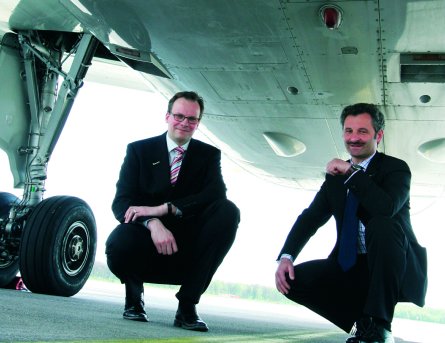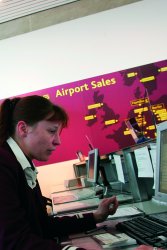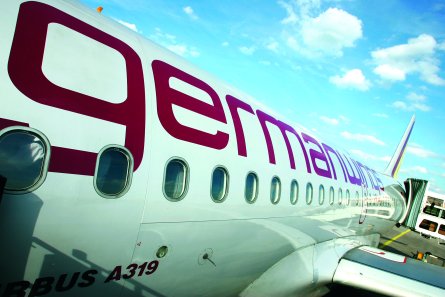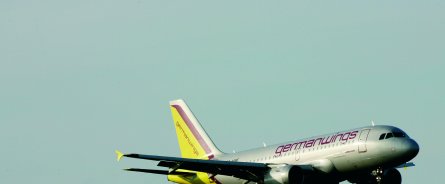By Jackie Thompson and Mark Pilling in London Photography by Etienne de Malglaive
Although the leaders of germanwings insist they are not Lufthansa puppets, it is clear there are strong links between the low-cost carrier and its parent
Only a handful of carriers have tried to make the jump from the regional to the low-cost model. Some are flourishing, but others have failed. The UK’s flybe and Ireland’s Aer Arann are making a decent job of it, but US player Independence Air collapsed. Another notable European experiment is more than holding its own in a toughening market. That experiment is the brainchild of German regional Eurowings, with its germanwings offshoot and with Lufthansa as its mothership.
 |
Cynics suggest family favours go a long way to explaining the success of germanwings. Admittedly, the carrier is effectively wholly owned by the German flag carrier in a complicated ownership structure, explains chairman of the executive board Dr Joachim Klein (seen far right). And yes, germanwings “cherry-picks” the best things that come from being under Lufthansa’s wing, says Dr Andreas Bierwirth (seen far left), germanwings managing director.
But no, when it comes to critical business and market decisions, like network planning, yield management and commercial direction, then germanwings goes it alone, completely. In German, Lufthansa’s approach is a “Vollsortimenter”, or multi-brand strategy, says Bierwirth. “In this strategy, Mr Mayrhuber [Lufthansa group chairman] makes it clear that all brands have the full flexibility to act and react as their chief executives and managing directors think is the right way,” says Bierwirth. “So there is not a clear objective or a clear target except earning money. That is a very clear target. There is no target to co-ordinate, for one company to speak to the other and to find the end strategy. The strategy is more like General Electric’s.”
In fact, Lufthansa was not keen on germanwings parent Eurowings, a successful regional feeder for Air France, KLM and Lufthansa, entering the low-cost market in the first place. “Lufthansa was not convinced back in 2001 about this business model,” says Klein, who joined in 2000, and hired Bierwirth in early 2002 as germanwings was taking shape. At that time Lufthansa was beginning to take a tighter grip on the destiny of its feeder following the doubling of its 24.9% stake in Eurowings to 49% in 2001. Despite its reservations, Lufthansa supported the core group of Bierwirth, Klein and Eurowings chief executive Friedrich-Wilhelm Weitholz as they moulded the germanwings plan.
Lufthansa relationship
“Lufthansa was very smart from the beginning,” says Bierwirth. “There were a lot of discussions about what the success factors of a low-cost carrier linked with a legacy carrier would be.” Lufthansa would not support the venture financially, nor would it dictate the carrier’s business objectives or where it should fly. In 2002 when germanwings was launched it was viewed by the flag carrier very much as a trial.
To the Eurowings team it was much more. The company needed to stop being so reliant on its feeder role, says Klein. But time was short. “Strategically, the window was open, but we knew it would not be open for long,” says Bierwirth, as easyJet was moving in. The UK-based low-cost carrier, which had taken out an option to acquire DBA, a German carrier owned by British Airways, was building its German presence. In five months the infrastructure needed to get germanwings off the ground was created and the carrier began operating in October 2002 with five Airbus A319s switched from the Eurowings charter operation.
Germanwings labels itself as conservative in growth terms, but its rise has been faster than expected, says Klein. “When we started we intended to have 11 aircraft in three years. In our first year of operation [2003] we had 12 aircraft. We now have 24.” The carrier is expanding rapidly nonetheless. This year it will offer 60% more seats compared with 2005. “In the past two years we have seen a lot of opportunities and we’ve taken them,” says Klein.
These opportunities have seen germanwings establish a base at Berlin Schoenefeld in mid-2005 and another in Hamburg at the end of last year, says Klein. Each base has two aircraft, making them relative minnows compared with Stuttgart, which has six, and the original Cologne/Bonn airport base, which has 14. It now serves 46 destinations from Cologne and has captured over 35% of the market. “Our goal is to be at least number two in any market,” says Klein. “We look at hub bases where we can have at least five aircraft,” he adds, with Berlin and Hamburg still in the work-up phase. At Cologne and Stuttgart, where it has a 20% marketshare, the carrier is the market leader. At Berlin it is number two to easyJet, while at Hamburg it is further down the pecking order.
Bierwirth admits that germanwings does find itself in direct competition with Lufthansa at Hamburg, but only on a couple of routes. They go head to head from Hamburg to London Gatwick, and also Hamburg-Munich. Otherwise, he says, “on more or less the rest of our routes such as Toulouse or Bologna, Lufthansa is not flying at all so there is no competition”. He insists that concerns about possible conflict are more media driven than an issue for the carriers themselves. However, he agrees that a Lufthansa move into the Stuttgart market could present a threat. “If Lufthansa is moving over to Stuttgart this can affect us because our airline is market leader there,” he says.
Whatever Lufthansa does, germanwings is seeking out new airports as it grows. There are plans to increase its fleet to 35 aircraft by 2008, which means that the search is on for a fifth base. “We are already searching for it,” says Bierwirth. He believes there are still a couple of opportunities to establish another germanwings base in Germany, and the carrier is also working on its first base outside the home market. “We’ve got three airports in mind in and outside Germany. All the airports and catchments we are studying are underserved by low-cost carriers.” There are no easy pickings any more, however. “It is getting harder to find the right airports,” comments Klein.
 |
More profits please
As it becomes established after four years of swift growth, the focus on the bottom line is getting sharper. Following two years of just creeping into the black, “the time is coming in the next years to earn money,” says Bierwirth. The carrier lost money in 2003, made a net profit of €1.1 million ($1.4 million) in 2004, and netted €1 million last year on a turnover of €400 million. This is broadly in line with the original business plan and has been achieved with fuel prices that are far greater than anticipated back in 2002, Klein explains. The original investment made by Eurowings is not disclosed. “Our aim in the past two years has been not to lose money and achieve a high degree of growth,” adds Bierwirth.
“We intend to build an acceptable profitability this year,” says Klein, but fuel price rises have put a spanner in the works. “When we started this year our budgets were calculated based on an oil price of $64 [per barrel] and they’ve risen to $73. It’s a nightmare.” The drive to higher returns has led germanwings to be one of the few low-cost carriers to introduce a fuel surcharge. This will add €1-2 to average ticket prices and, in the German market at least, passengers appear willing to pay, says Bierwirth.
 |
| "It is a very important part of our strategy to be the leading low-cost airline in the east European market." Andreas Bierwirth (right) |
Overall the carrier is expecting revenue to rise to around €570 million this year carrying 7.5 million passengers. “For us, a realistic annual margin for the future, with 10-20% annual growth, would be around a double-digit number,” he says. This will not be reached this year, but the hope is for progress towards this goal.
Although already lean, germanwings is far from finished with cutting costs from the business. Moving to a paperless cockpit will help, as will rolling out self-service check-in kiosks at its main bases, says Klein. Some measures are greatly aided by the carrier’s association with Lufthansa. One of the areas where germanwings relies on the strength of its parent is in pilot training and recruitment. Since 2005, after signing a new collective agreement with its pilots union, the carrier has received all of its new first officers from Lufthansa’s flight training school in Bremen. After a minimum of six years they can move to Lufthansa.
Germanwings pilots are paid less than their Lufthansa counterparts, contributing to the cost advantage the low-cost carrier enjoys. “For us it is a big advantage,” says Klein. “We don’t have problems recruiting, being part of the Lufthansa flight organisation. For our next development steps for new aircraft the crews are already in training.” The movement of staff from germanwings to Lufthansa is not restricted to flight crew. Bierwirth himself will transfer across to the parent carrier later this year, helping to inject a little “low-cost airline DNA” into Lufthansa’s management team.
Revenue growth is also coming from outside the main passenger-carrying airline. “We are currently working for DHL, we perform charter flights for tour operators and the next project will be with Cargo Counts starting this summer,” he says. Cargo Counts, a Lufthansa subsidiary, is an outsource cargo management company that enables carriers without a cargo sales operation to tap this revenue source.
Germanwings at a glance Revenue $495 million Year end December 2005 |
Adding frills
Although clearly an airline in the low-cost mould, germanwings is not averse to adding a few frills here and there. For example, it is one of the few low-cost carriers to have introduced a frequent flyer programme. Dubbed the “Boomerang Club”, members can obtain credit for germanwings flights as well as bookings with rental car and hotel partners. While budget carriers have typically shunned such schemes because of their additional cost, Bierwirth insists that the new internet-based programme “does not bring any more complexity to our business, and does not cost much. It’s very simple, it works automatically, but it’s very effective.”
Another innovation is the germanwings credit card. This costs about €40-50 a year and offers all the same benefits as any other credit card, but in addition passengers who book flights using their card are guaranteed to be in the first boarding allocation, no matter what time they arrive at the airport.
The carrier is also considering introducing paid-for lounge access, but Bierwirth says this will not be easy to realise and it may well not be in the Lufthansa lounge. “We have the same terminals as Lufthansa, but they have never sold lounge access to other people.” He laughs: “I think even Ryanair sees lounge access as an interesting way of getting extra revenue.”
 |
In-flight entertainment is another possibility for the future. “We are investigating this, but the problem is that for this to earn money you need the right stage length. For example, JetBlue has a stage length of two to three hours flying coast to coast and this is fine, but our longest staging is one hour and 10 minutes and there you are not even able to watch a video of 30-40 minutes,” says Bierwirth.
Germanwings also books additional revenue from its relationship with centralwings, the low-cost arm of Polish flag carrier LOT and, like Lufthansa, a member of Star Alliance. The carrier forged a partnership with centralwings at the beginning of 2005. The deal sees germanwings hosting the IT services of centralwings and the two carriers linking their websites for ticket sales. In effect, germanwings is providing a consultancy service for the other carrier, explains Bierwirth. The two airlines also negotiate jointly for airport services. “When we go to the airports we go together. This is not seen in public but is the kind of synergy that we can achieve,” he says.
The relationship with centralwings, and possibly others, could go a lot further. In parallel with developing germanwings, management is brokering the “European Wings” concept as a way of gaining low-cost mass to rival easyJet and Ryanair in size. “It is not possible for us to do it alone,” says Bierwirth. “The only way is to join up with local forces.” The idea is to develop a pan-European strategy with local competence at low risk, he explains. Germanwings is looking to add another like-minded carrier to the fold by the end of the year and is in discussions with several in other parts of Europe, says Bierwirth. “It is not easy to manage, but we see a possibility in this system.”
So where will germanwings end up in Europe’s low-cost endgame? “I think low-cost carriers will grow probably between 10% and 20% per year over the next five years so that by the end of 2010 there will be more than 400 million seats available in this business model,” says Klein. This year Europe’s low-cost players will offer some 150 million. Not all of today’s players will be around to take their share, believes Klein. “There will be a kind of concentration and you will see between 10 and 15 major low-cost carriers in Europe.”
 |
Germanwings is planning to be one of those. By 2008 it will be carrying over 10 million passengers on 35 aircraft. With 12 A319s on option for delivery from late 2007 the carrier has no problem growing still further, says Klein. The next stage will be to hit what he describes as a “critical mass” of 50 aircraft. There is no firm timescale for this target, but even with its in-built conservatism it would not be surprising to see germanwings reach that point sooner rather than later. ■
Joint direction Dr Joachim Klein entered the airline business in April 2000 when he joined the Eurowings board. He is also chairman of the management board at the company’s low-cost subsidiary germanwings where he is responsible for finance, human resources, IT and operations. His career has seen him working for several major automotive manufacturers and latterly mainly in the logistics industry. Klein was solely responsible for running germanwings until Dr Andreas Bierwirth was brought in as joint managing director in early 2005. Klein studied business management and commercial IT at Saarland University. Bierwirth is responsible for marketing and product, sales and business development at germanwings. From 1993-7 he studied business management at the University of Münster and worked at the Institute for Marketing there. He was then made managing director at Westair in Dortmund. In April 2002 he joined the management team of Eurowings Flug, which in September that year became germanwings. When Bierwirth moves to Lufthansa as marketing manager responsible for brand management, marketing, market research and customer analysis in September he will be succeeded by Lufthansa’s vice-president for the Americas, Thomas Winkelmann. |
Click here for more Airline Business interviews
Source: Airline Business























